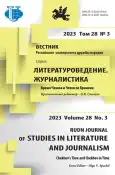Coverage of the One Belt, One Road Initiative by Russia Today TV channel as a way of understanding Russian-Chinese relations
- Autores: You K.1, Shilina M.G.2,3, Qi Y.4
-
Afiliações:
- Tsinghua University
- Plekhanov Russian University of Economics
- Lomonosov Moscow State University
- Donghua University
- Edição: Volume 28, Nº 3 (2023): Chekhov’s Time and Chekhov in Time
- Páginas: 566-573
- Seção: JOURNALISM
- URL: https://journal-vniispk.ru/2312-9220/article/view/319070
- DOI: https://doi.org/10.22363/2312-9220-2023-28-3-566-573
- EDN: https://elibrary.ru/LWZBLR
- ID: 319070
Citar
Texto integral
Resumo
The authors conduct a comparative analysis of how Russia Today (RT) report on China's One Belt and Road Initiative (OBOR). Focused on the question of how this state-owned media reflect the bilateral relations between Russia and China, the study reveals that RT serve as mirrors of their governments' attitudes towards China's geopolitical strategy. While only English language coverage by RT is considered, this focus offers a unique insight into Russia's portrayal of the OBOR. The work fills a significant gap in understanding this dynamic and offers new insights through a blended methodological approach. Utilizing quantitative content analysis and qualitative thematic analysis, this pioneering research evaluates the coverage of OBOR by RT (2013-2022), uncovering a previously unexplored interplay between state-owned media narratives and governmental geopolitical relations. It provides a novel perspective on understanding the complex relations between China and Russia through the lens of media reporting. It underscores the role of state-owned media as a tool to shape perceptions and inform the narrative surrounding global initiatives such as OBOR. The study's findings offer insights into the broader discourse around OBOR and its global implications, contributing to the scholarship on international relations, media studies, and Chinese foreign policy.
Palavras-chave
Sobre autores
Keke You
Tsinghua University
Email: kelcey@mail.tsinghua.edu.cn
ORCID ID: 0000-0002-0433-1558
research assistant, Department of Journalism and Communication
1 Shuangqing Rd, Haidian District, Beijing, 100084, People’s Republic of ChinaMarina Shilina
Plekhanov Russian University of Economics; Lomonosov Moscow State University
Autor responsável pela correspondência
Email: marina.shilina@gmail.com
ORCID ID: 0000-0002-9608-352X
Dr. Sc., Professor, Professor of the Department of Advertising, Public Relations and Design, Plekhsnov Russian University of Economics; Professor of the Department of Advertising and Public Relations, Faculty of Journalism, Lomonosov Moscow State University
36 Stremyanny Pereulok, Moscow, 117997, Russian Federation; 9 Mokhovaya St, bldg 1, Moscow, 125009, Russian FederationYuanbo Qi
Donghua University
Email: y.qi@dhu.edu.cn
ORCID ID: 0000-0001-9541-8220
lecturer, Department of Communication, School of Humanities
1882 West Yan'an Rd, Shanghai, 200051, People’s Republic of ChinaBibliografia
- Aksenov, G., Li, R., Abbas, Q., Fambo, H., Popkov, S., Pankratov, V., Kosov, M., Elyakova, I., & Vasilijeva, M. (2023). Development of trade and financial-economical relationships between China and Russia: A study based on the Trade Gravity Model. Sustainability, 15(7), 6099. https://doi.org/10.3390/su15076099
- Bolaev, A.V. (2023). The Eurasia canal project in the context of the China’s Belt and Road initiative. Russian Law Journal, 11(10), 623-633. https://doi.org/10.52783/rlj.v11i10s.1763
- Ghossein, T., Hoekman, B., & Shingal, A. (2021). Public procurement, regional integration, and the Belt and Road Initiative. The World Bank Research Observer, 36(2), 131-163. https://doi.org/10.1093/wbro/lkab004
- Jiang, Y. (2022). Framing the Belt and Road Initiative: Australian mainstream media narratives from 2013 to 2020 (thesis for Doctor of Philosophy). Queensland University of Technology.
- Kuteleva, A., & Vasiliev, D. (2020). China’s Belt and Road Initiative in Russian media: Politics of narratives, images, and metaphors. Eurasian Geography and Economics, 62(5-6), 582-606. https://doi.org/10.1080/15387216.2020.1833228
- Maçães, B. (2018). Belt and Road: A Chinese world order. Oxford: Oxford University Press.
- Mayer, M., & Zhang, X. (2020). Theorizing China - World Integration: Sociospatial reconfigurations and the modern silk roads. Review of International Political Economy, 28(4), 974-1003. https://doi.org/10.1080/09692290.2020.1741424
- Mendez, A., Forcadell, F.J., & Horiachko, K. (2022). Russia - Ukraine crisis: China’s Belt Road Initiative at the crossroads. Asian Business & Management, 21(4), 488-496. https://doi.org/10.1057/s41291-022-00195-1
- Shah, A.R. (2023). Revisiting China threat: The US’ Securitization of the ‘Belt and Road Initiative’. Chinese Political Science Review, 8, 84-104. https://doi.org/10.1007/s41111-021-00179-0
- Shilina, M.G. (2022). Mediatization in the context of the global crisis: Temporality as a research modality. Russian School of Public Relations, (24), 45-57. (In Russ.)
- Van Noort, C., & Chatterje-Doody, P.M. (2023). China’s Belt and Road Initiative on RT (Russia Today): From infrastructural project to human development. Eurasian Geography and Economics, 64(4), 431-459. https://doi.org/10.1080/15387216.2021.2005650
- Yang, H., & van Gorp, B. (2021). Frame analysis of political-media discourse on the Belt and Road Initiative: Evidence from China, Australia, India, Japan, the United Kingdom, and the United States. Cambridge Review of International Affairs, 36(5), 625-651. https://doi.org/10.1080/09557571.2021.1968794
- Yu, L., Zhao, D., Niu, H., & Lu, F. (2020). Does the Belt and Road Initiative expand China’s export potential to countries along the Belt and Road? China Economic Review, 60, 101419-101421. https://doi.org/10.1016/j.chieco.2020.101419
Arquivos suplementares









